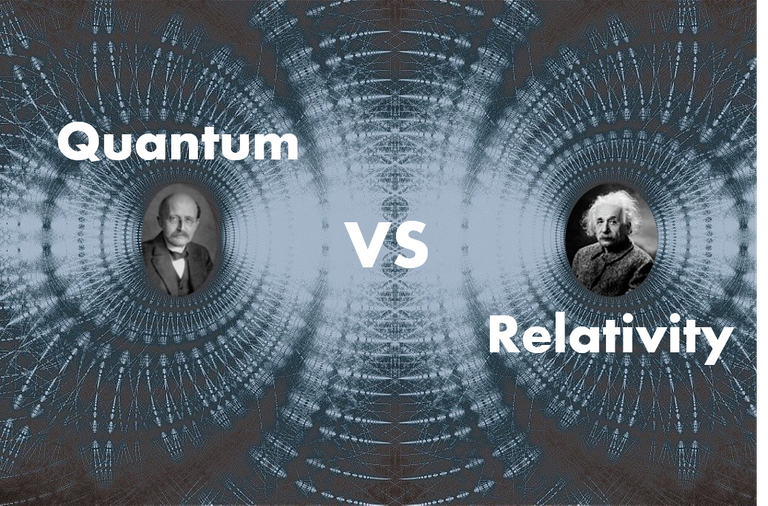

But why is it that interactions as different as electromagnetism and nuclear forces have been able to become quantum while gravity has not? One answer that popularizers often give is that, when you try to combine these two things, the resulting theory fails by spitting absurdities at you; probabilities, and quantities that should have a concrete value now go off to infinity.
However, this answer is not very revealing, it simply tells you that if you mix this with this the result is a disaster. Which brings me to the first question: Why is it a disaster? Well! The answer is that going back to quantum gravity is a challenge of a different nature. The process by which one makes a certain force or a particle of matter quantum is, very roughly, like this: on spacetime you place a field with properties that suit your needs, then you force this field to follow the quantum rules and, with the help of countless tricks, you can get all the predictions you need. The field will be responsible for generating the force or particle you want to explain.

For example, one thing that quantum fields must comply with is that if in a certain area it undergoes a perturbation, another area cannot "feel" it instantly. They always have to respect the speed of light, the maximum speed of the universe. This is the microcausality condition, so you impose it and modify the field to meet it: which regions are causally connected and which are not.
But how do you impose this on the curvature of spacetime? Because what tells you which regions are causally connected is the spacetime curvature. That is, you want to modify a thing using as a basis that same thing that you are modifying... Using the same thing, which, in turn, is being modified by the same thing... etc.
You see the mess, don't you? Add to this more headaches: if matter and energy curve spacetime, if I have something in quantum superposition, does that mean that the curvature of spacetime should also be superposed? How does that work? How do we describe it correctly? And what about the observer in all this? If, for example, I am working with a superposition that encompasses the whole Universe, there is no external observer to make sense of it all! How could that be explained? So many questions and so few answers.
But what if the answer is that we are forcing the issue, what if gravity really isn't quantum, General Relativity and Quantum Relativity hate each other and go their separate ways? The move is that physicists know that there must be a meeting point between the two. Think about this, imagine that we have two electrons separated by a few millimeters, on these two are acting two forces: the electrical repulsion that wants to separate them and the gravitational attraction that wants to bring them together. What happens? That their masses are so small that the force of gravity between them is minuscule, it is ridiculous in comparison with the intensity of their electrical repulsion.

Remember Einstein, mass and energy are equivalent, so that potential energy is contributing to increase the effective mass of the electrons. The more mass, the more gravity, so that, in this approach, there comes a time when the electric force and the gravitational force end up being equal. That is to say, there is no separation here: there is an extreme of the world in which gravity and the quantum world coexist together. This distance is called the Planck distance.
On the Planck scale, quantum gravity must manifest itself. And someone will say to me "but, if we know that this is the answer, why don't we explore it? Why don't we build a machine to bring the electrons closer and see what happens?" Quick answer: because we don't know how.
The Large Hadron Collider (LHC), suppose the machine that can bring two particles closer together, falls short by hundreds of billions of times. With today's technology, we would need an accelerator the size of the solar system, and the oven is not up to snuff. We still have a long way to go before we can explore these regions of the universe, test the quantum gravity proposals and see if any of them are correct. But beyond that there is theoretical hope, because, despite the tension between the two theories, quantum seems to be loosening up a bit. Because (and this is a result that drives me crazy) if you construct a field with properties very similar to those of the curvature of spacetime and force it to be quantum, this imposition allows only one result.
The result is that that field interacts with other particles making them attract, just like gravity, and that attraction is very similar to the one described by general relativity. That is, without forcing quantum to look like anything, it itself winks at us. Coincidence or is there really room for understanding?


Congratulations @rafabvr! You have completed the following achievement on the Hive blockchain and have been rewarded with new badge(s) :
Your next target is to reach 20000 upvotes.
You can view your badges on your board and compare yourself to others in the Ranking
If you no longer want to receive notifications, reply to this comment with the word
STOPCheck out the last post from @hivebuzz:
Thanks for your contribution to the STEMsocial community. Feel free to join us on discord to get to know the rest of us!
Please consider supporting our funding proposal, approving our witness (@stem.witness) or delegating to the @stemsocial account (for some ROI).
Please consider using the STEMsocial app
app and including @stemsocial as a beneficiary to get a stronger support.
Thank you very much, I am happy to share my content in this community. I tried to post from the application but it didn't allow me, I don't know if it was due to connection problems. I will try in the future.
Hi rafabvr,
Visit curiehive.com or join the Curie Discord community to learn more.
Thank you for your support, many blessings.